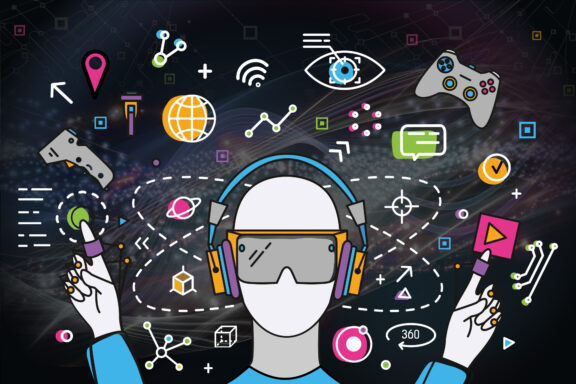The media and entertainment industry is an ever-evolving one to say the very least, constantly changing and reshaping itself with technological advances always at the forefront of these innovations.
The Covid-19 pandemic has seen our media and entertainment consumption skyrocket for various reasons – from having more time on our hands to a greater need to escape from our current realities, and technology has facilitated this.
In a world where entertainment is never further away than at the end of our fingertips – what is next for media and entertainment technology?
Read on to find out the top technologies sweeping this thrilling sector.
Better Data Security and Transparency
Now in our third U.K-wide lockdown and with many people around the world unable to work, content streaming has seen a huge rise.
Therefore, the amount of data collected related to our streaming habits has increased too.
This means that media corporations have a responsibility to be transparent about the data they hold on us and how it’s being used, as well as ensuring the data is suitably secured.
Recent research by SAS and Futurum Research shows that 73% of consumers believe the use of their data is “out of control”.
Media outlets must become more transparent about their data collection and usage practices to remain trustworthy in the eyes of consumers.
Companies which fail to do this may face reduced customer loyalty and therefore a declining customer base.
OTT Content Advertisements
One of the main reasons consumers first began to move from traditional TV watching to streaming from digital on-demand platforms like Amazon Prime is because they could watch their favourite films and shows without being interrupted by an advertisement break every 15 minutes.
This was a more premium viewing experience for audiences and is still considered to be one of the best features of these platforms.
However, top TV studios and media conglomerates who are entering the on-demand streaming sphere are considering adopting ad-supported content business models to remain competitive and maximise revenue gained from corporate sponsorships and ad sales.
This is expected to follow a similar approach to YouTube, which was one of the first online content platforms to launch a monetisation model such as this.
Research suggests that audiences tend to sit patiently and wait for YouTube adverts to finish whilst TV watchers are more likely to leave the room or change the channel to avoid watching them.
So, it makes sense for TV studios entering this space to introduce adverts because greater viewership of their ad slots means they can charge more to companies looking to advertise with them.
This is a digital streaming trend we can expect to emerge throughout 2023.
Bundled Content Services
As mentioned before, the media and entertainment industry is always changing and the lines between the roles of different areas within the sectors and becoming more and more blurred.
For example, Amazon launched Amazon Prime in 2007 and later Amazon Music, even though the platform was previously only viewed as an e-commerce website.
Another example is Disney launching Disney+ last year, allowing them to keep everything under one roof where it usually would have granted permission for other platforms to host its extensive repertoire of films and tv shows.
Not only does this strengthen the Disney brand but it means that it creates a steady and predictable revenue.
In the future, we can expect media business strategies and technology to advance together to allow the creation of platforms that offer everything from films and series to AR and VR entertainment content.
Perhaps Netflix will introduce extra features within areas it doesn’t currently have a market share in with adapted subscription levels.
E-Sports and Gaming Industry Boost
When sporting events were restricted for health and safety reasons last year, many sports fans filled that gap with e-sports or other gaming activities.
Fast forward a year and e-sports have become a major driving force for interest in interactive gaming, technology and immersive user experiences.
Experts predict that the gaming industry will follow a similar trajectory to other digital technologies such as social media, mobile apps and e-commerce. By this we mean that it will cause fundamental changes to the ways people interact with each other and the state of the internet as a whole.
To that end, we can expect more digital activities (social, live entertainment events and betting) to take place actually inside games.
Virtual Escapism
More and more of us are looking to media and entertainment as an escape from the pressures that can come from living through a global pandemic.
Musicians, artists, public figures and celebrities are using virtual technologies to bridge the gap caused by the pandemic between them and their fans with many concerts and public appearances being cancelled for safety purposes.
Whilst the future remains uncertain for now, we can expect this to continue and become even more popular.
Today’s technology has brought about a deepness of connection between fans and celebrities that have never been possible before now.
Virtual performances and interactions on social media are one aspect of that but with the popular game Fortnite’s fully-immersive Travis Scott concert capturing the interest and imagination of the world back in April 2020, a new standard has been set.
Research shows that the top non-gaming events amongst gamers over the last 12 months fell under the category of live in-game concerts, with 40% of participants preferring them to other in-game activities and events like movie and tv show previews, sports-related content and virtual simulations of social/life events like birthdays.
2023 is expected to bring even more creative and exciting approaches to fan engagement and virtual escapism.
In-person Event Safety Tech
Eventually, when it is completely safe to do so, we are going to return to in-person entertainment events like concerts, theatre performances, festivals and cinemas.
So that these events can stay as safe as possible, we can expect a range of tools and technologies to assist us with this task such as:
- Contactless transactions
- Ticketless admissions
- Remote food, drink and merchandise ordering
- Crowd control tech
- Temperature measurement devices
Everyone is looking forward to the return of these well-loved past times but these technologies will be essential to making sure we can continue taking part in them for as long as possible.
AI-Driven Entertainment
The potential that AI has to completely revolutionise operations in the media and entertainment industry is huge.
Currently, much of what we decide to watch on streaming services like Netflix are recommended to us by clever AI and machine learning algorithms that analyse our viewing behaviours to figure out what kind of content we enjoy.
The same can be seen on music apps like Spotify, which explains how you’re always getting recommended new music and artists to listen to that you eventually fall in love with.
We can expect these content recommendations to become even more specific as Big Data expands and the algorithms become more complex.
Streaming platforms that understand their audiences will always come out on top and AI is very useful for doing this.
Some of the key benefits of tailoring content to specific users include:
- Content relevant to specific users becomes more discoverable
- Average content consumption through the streaming service is increased
- Customers feel more valued as their interests are catered to, leading to high subscriber retention rates
AI is also being used behind the scenes, with some businesses using the technology to automate content editing, reducing human intervention and therefore lowering costs.
Further than that, artificial emotional intelligence will be huge for large media organisations and creative content publishers to accurately understand how the entertainment they create will affect consumers on an emotional level.
This will be helpful for marketing and advertising strategists working within the industry too as potentially harmful or offensive media campaigns can be nipped in the bud by artificial emotional intelligence tools before they are released into the public domain, saving them from a PR crisis or embarrassment.
4K UHD Standardisation
Until now, the uptake for 4K Ultra-HD TVs has been slow. Yet, experts expect these advanced viewing devices to become more common in homes across the world.
This is due to falling average unit prices with CTA predicting in 2019 that 50% of TVs sold in 2020 would be 4K TVs – the highest proportion since they were launched.
Most of the major streaming services like Netflix, Amazon Prime and Hulu all offer content in 4K, as well as major game console producers Sony and Microsoft, however traditionally broadcast TV stations scarcely do.
The pressure is now on them to adapt in line with the standards set out by their competitors if they want to defend their current market share and keep their remaining customers.
Is your app or software idea going to be the next big thing in media and entertainment technology?
Coderus is a leading software and app solution provider for the entertainment industry and we’re always committed to bringing the most creative and innovative technologies to the world.
Get in touch with us today to find out how we can help you with your next project.























